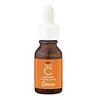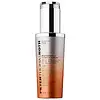What's inside
What's inside
 Key Ingredients
Key Ingredients

 Benefits
Benefits

 Concerns
Concerns

 Ingredients Side-by-side
Ingredients Side-by-side

Water
Skin ConditioningGlycerin
HumectantPEG-40 Hydrogenated Castor Oil
EmulsifyingPropylene Glycol
Humectant3-O-Ethyl Ascorbic Acid
Skin ConditioningAscorbyl Tetraisopalmitate
AntioxidantPhenoxyethanol
PreservativeCaprylyl Glycol
EmollientSodium Benzoate
MaskingXanthan Gum
EmulsifyingAcrylates/C10-30 Alkyl Acrylate Crosspolymer
Emulsion StabilisingNeopentyl Glycol Diheptanoate
EmollientTocopheryl Acetate
AntioxidantTrisodium Ethylenediamine Disuccinate
Butylene Glycol
HumectantSodium Hyaluronate
HumectantParfum
MaskingDipropylene Glycol
HumectantLimonene
PerfumingCitrus Junos Fruit Extract
Skin ConditioningCI 15985
Cosmetic ColorantCI 19140
Cosmetic ColorantCI 42090
Cosmetic ColorantWater, Glycerin, PEG-40 Hydrogenated Castor Oil, Propylene Glycol, 3-O-Ethyl Ascorbic Acid, Ascorbyl Tetraisopalmitate, Phenoxyethanol, Caprylyl Glycol, Sodium Benzoate, Xanthan Gum, Acrylates/C10-30 Alkyl Acrylate Crosspolymer, Neopentyl Glycol Diheptanoate, Tocopheryl Acetate, Trisodium Ethylenediamine Disuccinate, Butylene Glycol, Sodium Hyaluronate, Parfum, Dipropylene Glycol, Limonene, Citrus Junos Fruit Extract, CI 15985, CI 19140, CI 42090
Water
Skin ConditioningTetrahexyldecyl Ascorbate
AntioxidantButylene Glycol
HumectantC9-12 Alkane
SolventCaprylyl Methicone
Skin ConditioningTocopheryl Acetate
AntioxidantC10-18 Triglycerides
EmollientPolyglyceryl-6 Distearate
EmulsifyingFerulic Acid
AntimicrobialSqualane
EmollientHydrogenated Lecithin
EmulsifyingPropanediol
SolventSodium Hyaluronate
HumectantZingiber Officinale Root Extract
MaskingCurcuma Longa Root Extract
MaskingPanax Ginseng Root Extract
EmollientJojoba Esters
EmollientLeuconostoc/Radish Root Ferment Filtrate
AntimicrobialCoco-Caprylate/Caprate
EmollientGlycerin
HumectantCetyl Alcohol
EmollientPolyglyceryl-3 Beeswax
EmulsifyingXanthan Gum
EmulsifyingDisodium EDTA
Mica
Cosmetic ColorantEthylhexylglycerin
Skin ConditioningPotassium Sorbate
PreservativeSodium Benzoate
MaskingPhenoxyethanol
PreservativeWater, Tetrahexyldecyl Ascorbate, Butylene Glycol, C9-12 Alkane, Caprylyl Methicone, Tocopheryl Acetate, C10-18 Triglycerides, Polyglyceryl-6 Distearate, Ferulic Acid, Squalane, Hydrogenated Lecithin, Propanediol, Sodium Hyaluronate, Zingiber Officinale Root Extract, Curcuma Longa Root Extract, Panax Ginseng Root Extract, Jojoba Esters, Leuconostoc/Radish Root Ferment Filtrate, Coco-Caprylate/Caprate, Glycerin, Cetyl Alcohol, Polyglyceryl-3 Beeswax, Xanthan Gum, Disodium EDTA, Mica, Ethylhexylglycerin, Potassium Sorbate, Sodium Benzoate, Phenoxyethanol
Ingredients Explained
These ingredients are found in both products.
Ingredients higher up in an ingredient list are typically present in a larger amount.
Butylene Glycol (or BG) is used within cosmetic products for a few different reasons:
Overall, Butylene Glycol is a safe and well-rounded ingredient that works well with other ingredients.
Though this ingredient works well with most skin types, some people with sensitive skin may experience a reaction such as allergic rashes, closed comedones, or itchiness.
Learn more about Butylene GlycolGlycerin is already naturally found in your skin. It helps moisturize and protect your skin.
A study from 2016 found glycerin to be more effective as a humectant than AHAs and hyaluronic acid.
As a humectant, it helps the skin stay hydrated by pulling moisture to your skin. The low molecular weight of glycerin allows it to pull moisture into the deeper layers of your skin.
Hydrated skin improves your skin barrier; Your skin barrier helps protect against irritants and bacteria.
Glycerin has also been found to have antimicrobial and antiviral properties. Due to these properties, glycerin is often used in wound and burn treatments.
In cosmetics, glycerin is usually derived from plants such as soybean or palm. However, it can also be sourced from animals, such as tallow or animal fat.
This ingredient is organic, colorless, odorless, and non-toxic.
Glycerin is the name for this ingredient in American English. British English uses Glycerol/Glycerine.
Learn more about GlycerinPhenoxyethanol is a preservative that has germicide, antimicrobial, and aromatic properties. Studies show that phenoxyethanol can prevent microbial growth. By itself, it has a scent that is similar to that of a rose.
It's often used in formulations along with Caprylyl Glycol to preserve the shelf life of products.
Sodium Benzoate is a preservative. It's used in both cosmetic and food products to inhibit the growth of mold and bacteria. It is typically produced synthetically.
Both the US FDA and EU Health Committee have approved the use of sodium benzoate. In the US, levels of 0.1% (of the total product) are allowed.
Sodium benzoate works as a preservative by inhibiting the growth of bacteria inside of cells. It prevents the cell from fermenting a type of sugar using an enzyme called phosphofructokinase.
It is the salt of benzoic acid. Foods containing sodium benzoate include soda, salad dressings, condiments, fruit juices, wines, and snack foods.
Studies for using ascorbic acid and sodium benzoate in cosmetics are lacking, especially in skincare routines with multiple steps.
We always recommend speaking with a professional, such as a dermatologist, if you have any concerns.
Learn more about Sodium BenzoateSodium Hyaluronate is hyaluronic acid's salt form. It is commonly derived from the sodium salt of hyaluronic acid.
Like hyaluronic acid, it is great at holding water and acts as a humectant. This makes it a great skin hydrating ingredient.
Sodium Hyaluronate is naturally occurring in our bodies and is mostly found in eye fluid and joints.
These are some other common types of Hyaluronic Acid:
Learn more about Sodium HyaluronateTocopheryl Acetate is AKA Vitamin E. It is an antioxidant and protects your skin from free radicals. Free radicals damage the skin by breaking down collagen.
One study found using Tocopheryl Acetate with Vitamin C decreased the number of sunburned cells.
Tocopheryl Acetate is commonly found in both skincare and dietary supplements.
Learn more about Tocopheryl AcetateWater. It's the most common cosmetic ingredient of all. You'll usually see it at the top of ingredient lists, meaning that it makes up the largest part of the product.
So why is it so popular? Water most often acts as a solvent - this means that it helps dissolve other ingredients into the formulation.
You'll also recognize water as that liquid we all need to stay alive. If you see this, drink a glass of water. Stay hydrated!
Learn more about WaterXanthan gum is used as a stabilizer and thickener within cosmetic products. It helps give products a sticky, thick feeling - preventing them from being too runny.
On the technical side of things, xanthan gum is a polysaccharide - a combination consisting of multiple sugar molecules bonded together.
Xanthan gum is a pretty common and great ingredient. It is a natural, non-toxic, non-irritating ingredient that is also commonly used in food products.
Learn more about Xanthan Gum